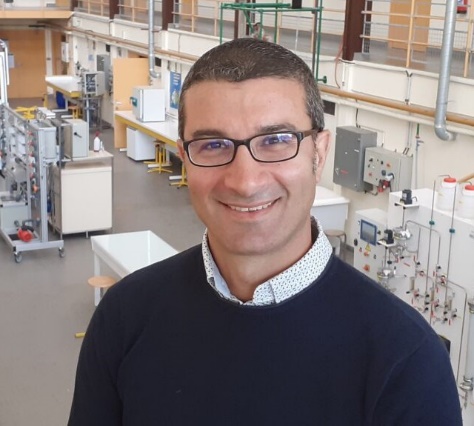
发布时间: 2024-05-29
报告一题目:From Panacea to Pollutant: a drug’s journey
报 告 人:Khalil Hanna 教授
邀 请 人:徐晶 副教授
时 间:2024年5月29日(星期三)上午9:30
地 点:水资源国重大楼A区202会议室

报告人简介:
Khalil Hanna教授于2001年在法国艾克斯-马赛大学(Aix-Marseille University)获得应用地球化学硕士学位;2004年在里昂国立应用科学学院(INSA de Lyon)获得环境化学博士学位;随后,在南特的中央桥梁与道路实验室进行了为期一年的博士后研究;2005至2011年,在南锡第一大学(Université Henri Poincaré)担任助理教授;自2011年起,成为雷恩国立高等化学学院(École Nationale Supérieure de Chimie de Rennes, ENSCR)的全职教授。
2013年,Hanna教授获得了布列塔尼地区杰出科学家奖,并在2017年成为法国大学研究院(Institut Universitaire de France, IUF)的成员。Hanna教授曾担任2013年Environmental Science and Pollution Research特刊的客座编辑,2013至2020年担任Applied Geochemistry的副主编,自2022年起成为Soil & Environmental Health的编辑委员会成员。
Hanna教授在国际研讨会和会议上进行了42场以上的特邀演讲和讲座,以及95场以上的口头报告。自2005年以来,指导了22名博士生、12名博士后和18名硕士生完成学业。Hanna教授获得了来自法国国家科学研究中心、欧盟委员会以及工业界的20多个项目的资助,累计经费超过280万欧元。Hanna教授已发表了160多篇同行评审的研究论文,截至2024年2月1日,其h指数为49,总引用次数超过8000次。
报告简介:
The ubiquitous existence of pharmaceuticals in many of our water resources is an emerging global threat with potentially alarming consequences for the health of the public and environment. Pharmaceuticals can enter the aquatic environment through three different routes: inefficient wastewater treatment, improper disposal of unused medicines, and agricultural run-off. Since current wastewater treatments are unable to completely eliminate these compounds, our daily exposure to various drugs and their bioactive metabolites in the environment becomes unavoidable. To ensure water safety, prevention of pollution at the source, complemented with wastewater treatment is key to addressing this problem.
As prevention is the best policy, and because daily exposure to various pharmaceuticals is becoming a reality through water consumption, we must question the most effective way to address escalating global pharmaceutical use. It would be more effective to focus on corrective measures of root causes, rather than simply treating the point where panacea becomes pollutant. Responsible use of drugs and personal care products by individuals is necessary to prevent the introduction of pharmaceuticals to the natural environment. Intensive information campaigns should be launched to educate the public and warn them about each individual’s responsibility and the ecological consequences of drug misuse.
In this talk, I will highlight our expertise on identifying pharmaceuticals and their transformation by-products, their mass flows through time and space, and the new physical and biological balances being temporarily created between living and non-living actors.
报告二题目:Fate and Transport of Emerging Contaminants in Natural Porous Media
报 告 人:Khalil Hanna 教授
邀 请 人:徐晶 副教授
时 间:2024年5月29日(星期三)下午2:30
地 点:水资源国重大楼A区328会议室
报告简介:
Good quality water, essential to sustain human well-being, livelihoods and a healthy environment, is increasingly threatened by a variety of chemicals, called emerging contaminants. Made to aid mankind, but now polluting, emerging contaminants arise from daily anthropogenic practices via domestic, healthcare, agricultural and industrial processes. These pollutants can be pharmaceuticals, hormones and steroids, disinfection by-products, personal care products, flame retardants, agrochemicals (pesticides, fertilizers and growth agents), etc. Because of their rapidly increasing use and incomplete removal in wastewater treatment, these chemicals enter the environment at increasing levels. Understanding how emerging contaminants interact with mineral surfaces will help to assess the fate, mobility and ecological impacts in environmental systems.
Fe- or Mn-oxyhydroxides are generally the dominant redox-active minerals in soils, sediments, and other oxide-rich environments. From an engineering point of view, metal-mediated redox reactions can be potentially applicable for environmental remediation and protection. From an environmental point of view, they can affect a wide range of processes, including biogeochemical cycling and availability of trace elements, degradation of organic matter and transport and mobility of emerging contaminants.
Our research interests focus on combining experimental investigations and modeling in order to improve understanding of surface reactions taking place at mineral/water interfaces. This speech will give some examples of our recent works on the implications of reactive minerals in controlling the fate and transport of emerging compounds in environmental systems.
报告三题目:PFAS: occurrence, fate and remediation
报 告 人:Khalil Hanna 教授
邀 请 人:徐晶 副教授
时 间:2024年6月1日(星期六)上午9:30
地 点:水资源国重大楼A区202会议室
报告简介:
Poly- and perfluoroalkyl substances (PFAS), a family of over 10,000 chemicals, have become emerging pollutants of global concern due to their widespread usage, ubiquitous environmental presence, extreme persistence, and toxicity. PFAS contain multiple carbonfluorine bonds (strongest bond in organic chemistry) that make them extremely stable. This stability has led to them being called “forever chemicals”. Despite soil’s well-documented role as a global sink and reservoir of PFAS contamination, our understanding of the fate PFAS in soils, their interactions with soil constituents and biota, and potential remediation methods remains limited. Soil largely contributes to the quality of groundwater and crops, which are potential human exposure pathways for these chemicals and, therefore, remediating PFAS contaminated soils is crucial. For this, a deeper understanding of PFAS interactions with diverse soil constituents is crucial for exploring their fate and developing efficient remediation technologies.
We aimed here to: i) Investigate the interactions of PFAS with soil constituents, including both mineral and organic components, alongside co-occurring contaminants. ii) Develop an efficient and cost-effective soil washing strategy designed to separate PFAS from soil. iii) Treat the soil washing effluent through a combination of adsorption integrated with advanced oxidation processes (AOPs) and/or photo-catalysis.
To separate PFAS from contaminated soils, we conducted soil washing with water and/or green extracting agents in combination with innovative air-based foam fractionation technology. Subsequent treatment of PFAS-laden soil washing effluent is then performed by integrating adsorption and degradation technologies (Advanced oxidation or reduction). To couple these processes, dual-functional magnetic materials possessing both functions (adsorbents and catalysts in AOPs) is developed using wastes from the local steel industry and agriculture in the context of circular economy. The treatment of soil washing effluent expands the applicability of this project beyond soil remediation to include water treatment or wastewater management. Meeting these objectives demands advancements in analytics, methods, and experiments, underscoring the need for an interdisciplinary approach. As stringent regulations on PFAS are expected in near future, the present lecture addresses a very timely challenge.
欢迎相关专业教师和研究生的光临!